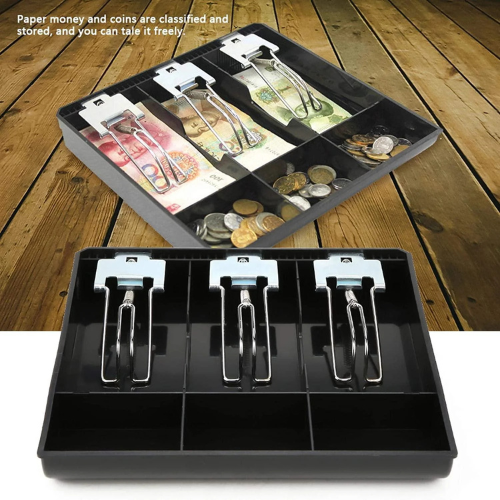Cash Drawer Register Insert Tray – Money Storage Box

A Cash Drawer is an essential component of any business that deals with cash transactions. Whether you run a retail store, a restaurant, or any other type of business requiring cash handling, having a secure and organized Cash Drawer ensures smooth financial operations. In this comprehensive guide, we will explore the importance of a Cash Drawer, its benefits, types, and how to choose the best one for your business.
What is a Cash Drawer?
A Cash Drawer is a secure, organized storage unit designed to hold cash, coins, and sometimes checks or receipts. It is commonly used in conjunction with a point-of-sale (POS) system or a cash register to facilitate easy and efficient money management. Most Cash Drawers come with separate compartments for bills and coins to help businesses keep their cash flow well-organized.
Benefits of Using a Cash Drawer
1. Improved Cash Organization
A Cash Drawer helps keep cash neatly sorted, making it easier for cashiers to provide change quickly. With dedicated compartments for bills and coins, it minimizes errors and speeds up transactions.
2. Enhanced Security
A lockable Cash Drawer ensures that money is safely stored, reducing the risk of theft or misplacement. Many models come with secure locking mechanisms that only authorized personnel can access.
3. Faster Transactions
Having a well-organized Cash Drawer allows cashiers to process transactions more efficiently, leading to shorter wait times for customers.
4. Reduces Counting Errors
Since cash is stored in separate compartments, it becomes easier to count and reconcile at the end of the day, minimizing discrepancies in cash handling.
5. Durability and Longevity
High-quality Cash Drawers are built to withstand frequent use, making them a long-term investment for businesses.
Types of Cash Drawers
1. Manual Cash Drawer
This type of Cash Drawer requires a key or lever to open. It is suitable for small businesses or low-volume cash handling setups.
2. Electronic Cash Drawer
An electronic Cash Drawer connects to a POS system and automatically opens when a transaction is processed. These are commonly used in retail stores, restaurants, and service businesses.
3. Printer-Driven Cash Drawer
This type opens when a connected receipt printer signals it, ensuring that it only opens after a successful transaction.
4. USB or Serial-Connected Cash Drawer
These models are linked directly to a POS system via USB or serial ports, providing seamless integration with digital payment systems.
5. Heavy-Duty Cash Drawer
Designed for high-traffic businesses, these Cash Drawers are made with robust materials and reinforced security features.
How to Choose the Best Cash Drawer for Your Business
When selecting a Cash Drawer, consider the following factors:
1. Size and Capacity
Ensure the Cash Drawer has enough compartments to hold the cash denominations your business commonly handles. If your business deals with large amounts of cash, opt for a larger drawer with more compartments.
2. Security Features
Look for Cash Drawers with lockable compartments, reinforced steel construction, and additional security mechanisms to prevent unauthorized access.
3. Integration with POS System
If you use a POS system, choose a Cash Drawer that is compatible with it. Electronic and USB-connected Cash Drawers work best with modern POS setups.
4. Material and Durability
A heavy-duty metal Cash Drawer offers greater durability and protection than plastic or lightweight models.
5. Ease of Use
Ensure the Cash Drawer is easy to open and close while also providing smooth operation for cashiers.
Setting Up and Maintaining a Cash Drawer
Step 1: Install the Cash Drawer
· Place the Cash Drawer on a stable, secure surface near the register or POS system.
· If it is an electronic model, connect it to the POS system following the manufacturer’s instructions.
Step 2: Organize the Bills and Coins
· Use the designated compartments to store different denominations of bills and coins.
· Keep commonly used bills at the front for quick access.
Step 3: Train Employees on Cash Handling
· Ensure employees understand how to operate the Cash Drawer securely.
· Train them on proper cash counting and reconciliation procedures.
Step 4: Secure the Cash Drawer
· Lock the drawer when it’s not in use to prevent unauthorized access.
· Limit the number of employees who have access to the key or password.
Step 5: Perform Regular Maintenance
· Clean the Cash Drawer periodically to prevent dust buildup.
· Check for any mechanical issues and repair them promptly.
· Count and reconcile cash at the end of each shift to ensure accuracy.
Best Practices for Using a Cash Drawer
1. Limit the Amount of Cash Stored – To reduce the risk of theft, periodically remove excess cash and store it in a secure safe.
2. Use a Secure Location – Keep the Cash Drawer in a place where only authorized personnel can access it.
3. Monitor Transactions – Use security cameras or transaction logs to track cash handling and prevent fraud.
4. Perform Regular Cash Audits – Conduct routine audits to ensure the accuracy of cash flow and prevent discrepancies.
5. Use a Float System – Start each shift with a set amount of cash to facilitate transactions smoothly.
Where to Buy a Cash Drawer
Cash Drawers are available from office supply stores, electronics retailers, and online marketplaces such as Amazon, Walmart, and Best Buy. When purchasing, consider customer reviews and product ratings to choose a reliable and durable model.
Conclusion
A Cash Drawer is an indispensable tool for businesses that handle cash transactions. It enhances organization, security, and efficiency, ensuring smooth financial operations. By choosing the right Cash Drawer based on size, security features, and compatibility with your POS system, you can streamline your cash handling process and improve overall business management.
- Art
- Causes
- Crafts
- Dance
- Drinks
- Film
- Fitness
- Food
- Games
- Gardening
- Health
- Home
- Literature
- Music
- Networking
- Other
- Party
- Religion
- Shopping
- Sports
- Theater
- Wellness


